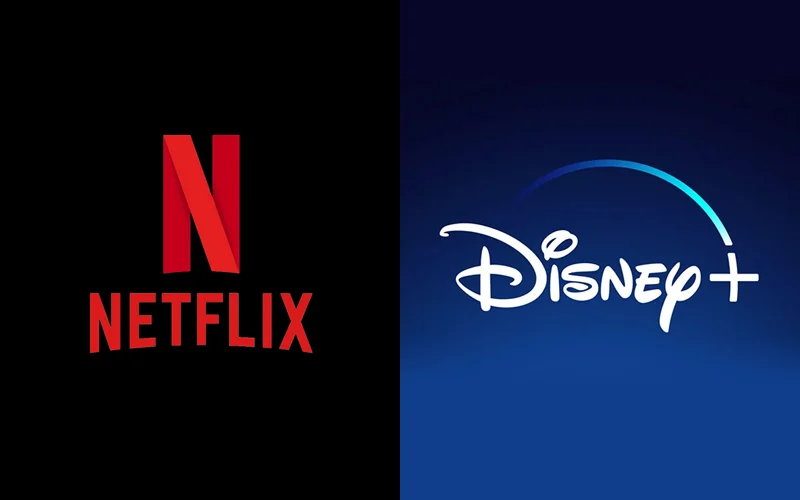Netflix or Disney? We compare revenue, user growth, and strategy to reveal which entertainment giant holds the better long-term investment edge.
🎬 Two Giants, Two Very Different Stories
In the dynamic world of digital entertainment, two names stand tall: Netflix and Disney. One is a tech-driven innovator born out of Silicon Valley, the other a legacy media empire with a century of global influence. But for investors, the burning question remains: Which company is the smarter investment?
This blog breaks down both giants in terms of history, business model, revenue streams, subscriber base, growth strategy, and long-term investment potential. Let’s dive in.
📽️ Company Background and Evolution
Netflix: The Digital Disruptor
Founded in 1997 as a DVD rental service, Netflix completely reshaped entertainment with the launch of its streaming platform in 2007. It didn’t just stream content—it started producing it. From House of Cards to Stranger Things, Netflix rapidly grew into a global content powerhouse. By 2024, it had over 230 million subscribers worldwide.
Disney: A Legacy Adapting to the Digital Age
The Walt Disney Company, founded in 1923, began with iconic animations and evolved into one of the world’s most diversified entertainment conglomerates. With acquisitions like Pixar, Marvel, Lucasfilm, and 21st Century Fox, Disney built a media empire. In 2019, it entered the streaming wars with Disney+, gaining tens of millions of subscribers within a year.
💵 Financial Models and Revenue Streams
Netflix: Subscription-Only Strategy
Netflix’s business model revolves primarily around subscription revenue. It offers various price tiers and recently added ad-supported plans to tap into new markets. In 2023, Netflix reported revenues approaching $34 billion.
- ✅ Advantage: Simplicity and scalability
- ❌ Disadvantage: Revenue relies heavily on user retention and growth
Disney: The Power of Diversification
Unlike Netflix, Disney boasts multiple revenue streams:
- Media networks (Disney+, Hulu, ESPN)
- Box office and licensing
- Theme parks and resorts
- Merchandising and consumer products
Disney’s total revenue reached nearly $88 billion in 2023. This diversification gives it a cushion against market shocks—if one sector slows, others can support the bottom line.
📈 Stock Market Performance
Netflix (NFLX)
- IPO: 2002 at $15/share
- All-time high: Nearly $690/share in 2021
- Correction in 2022: Dropped ~40% due to slowing subscriber growth
- 2023 recovery: Boosted by ad-tier plans and strong content slate
Disney (DIS)
- IPO: 1957 at $13.88/share
- Long-term performer: Strong institutional support
- COVID impact: Theme park closures affected earnings
- Rebound via Disney+: Streaming helped offset legacy sector losses
📊 Subscriber Growth and Market Share
| Platform | Subscribers (2024) | Annual Growth Rate |
| Netflix | 230 million+ | ~9% |
| Disney+ | 157 million+ | ~15% |
| Hulu | 50 million+ | ~5% |
| ESPN+ | 25 million+ | ~8% |
While Disney’s combined platforms are catching up, Netflix still dominates as a single-brand platform with the widest global footprint.
🚀 Future Strategy: Who’s Poised to Win?
Netflix’s Roadmap
- Ad-supported subscriptions to attract cost-conscious viewers
- Gaming and interactive content to expand beyond video
- AI in content creation and curation to optimize user engagement
Disney’s Long-Term Plan
- Profitability focus on Disney+, with selective content investments
- $60 billion expansion in theme parks planned by 2030
- Targeting India and Southeast Asia for international growth
Netflix leans hard into innovation, while Disney plays the long game with legacy assets and global brand loyalty.
🧠 Investor Analysis: Growth vs. Stability
| Metric | Netflix | Disney |
| Growth Potential | ✅ High | 🔄 Moderate |
| Revenue Diversity | ❌ Low (subscriptions) | ✅ High (multi-sector) |
| Profit Margins | Strong | Volatile |
| Risk Level | Medium-High | Low-Medium |
| Brand Power | Digital-first leader | Globally iconic |
Netflix offers higher upside for growth-focused investors, but also carries more risk due to its dependence on a single revenue stream.
Disney, on the other hand, delivers balance and resilience, appealing to investors who prefer stability with exposure to digital growth.
🔍 Which Stock Is the Better Buy?
Both companies are betting big on streaming, but their strategies couldn’t be more different.
- Netflix is leaner, faster, and more innovative—but exposed to disruption
- Disney is diversified, durable, and deeply embedded in global culture
If your portfolio needs a high-growth digital asset, Netflix might be a smart addition. But if you’re seeking a defensive, diversified investment, Disney could be the wiser long-term pick.
✅ Hollywood’s Investment King
In the world of streaming and entertainment, both Netflix and Disney are giants. The final choice depends on your investment philosophy:
- 🚀 Go Netflix for agility, tech-forward content, and global reach
- 🏰 Choose Disney for long-term value, asset diversity, and iconic IP
Just like choosing your favorite movie, there’s no one-size-fits-all answer—it’s about what role you want the stock to play in your portfolio.





Leave A Comment